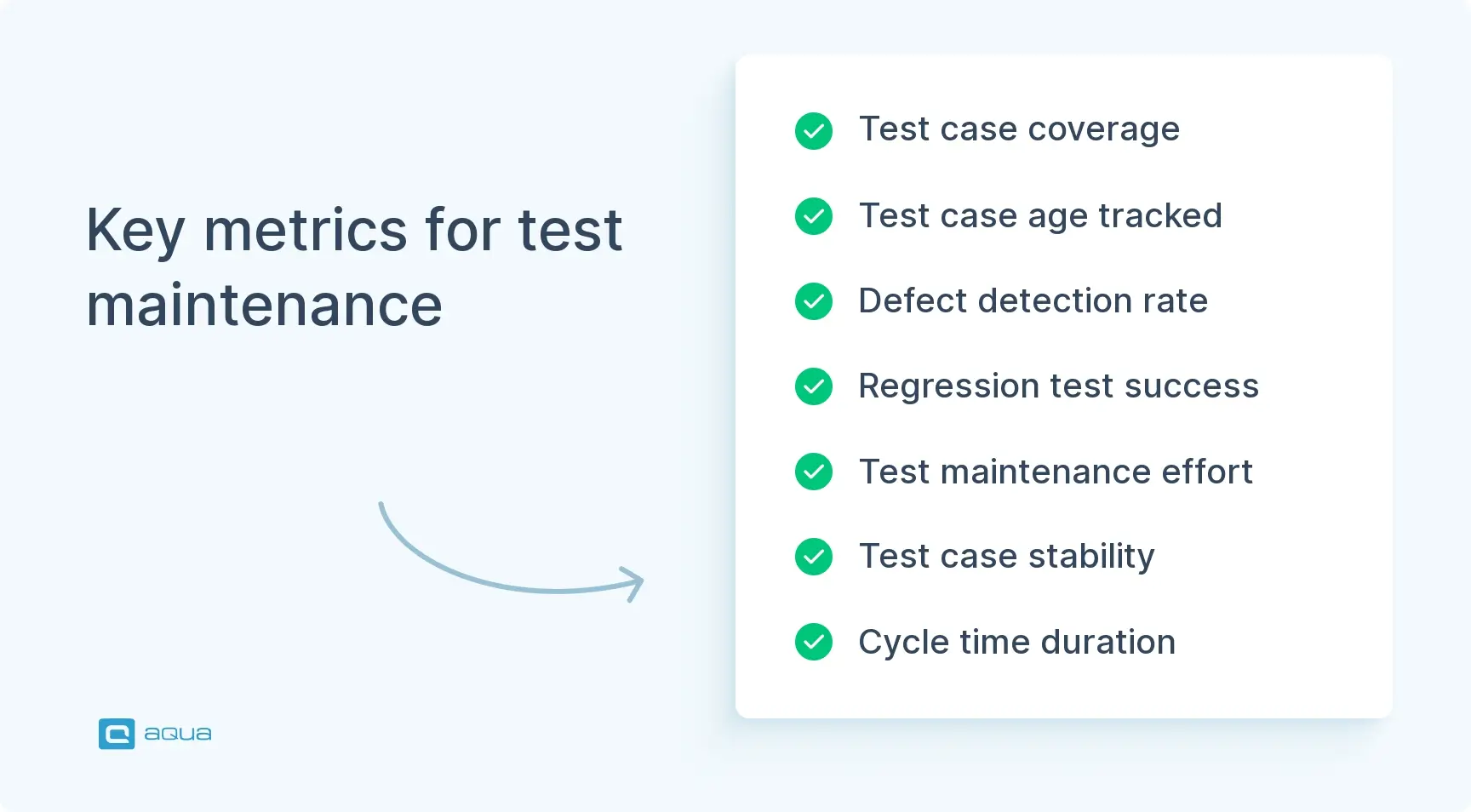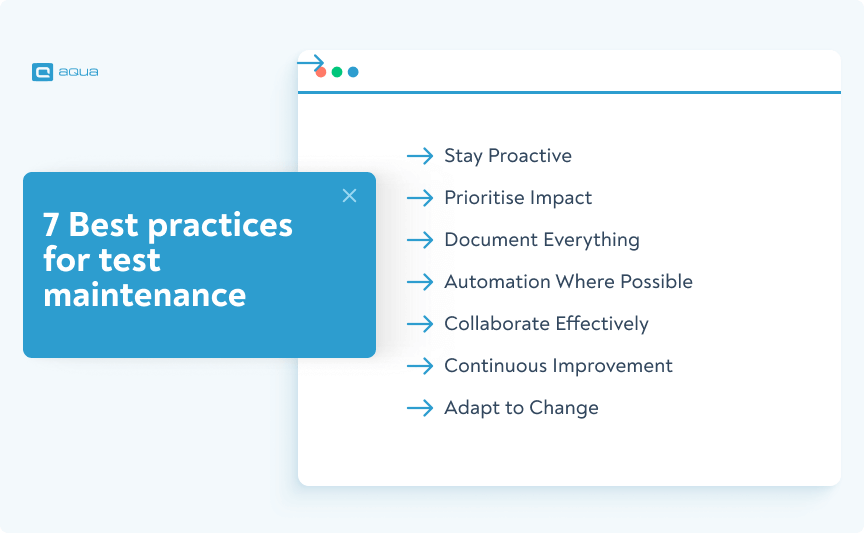Key Takeaways
- Test maintenance is the continuous process of updating, managing, and optimizing test cases to ensure their effectiveness as software evolves over time.
- Neglecting test maintenance increases the risk of undetected defects, with challenges including keeping up with software changes, managing test redundancy, and balancing automation with manual testing.
- Test data management is critical for reliable testing, with approximately 40% of mysterious test failures caused by data problems rather than actual code issues.
- Effective metrics for measuring test maintenance quality include test case coverage, defect detection rate, test case stability, and maintenance cycle time.
- AI-powered test management tools like aqua cloud can generate test cases in seconds, ensure complete requirement coverage, and reduce defect management time by up to 35%.
Maintaining your test suite is not a side task—it deserves the same attention as your production code. See how proper test maintenance can protect your software quality and save valuable resources below 👇
What is test maintenance?
Test maintenance is the continuous process of updating, managing, and optimising software test cases and test suites to ensure their effectiveness and relevance over time. It’s about updating your test cases to match changes in the software, adding new ones to cover new features, and eliminating any outdated ones. You’ll also need to organise your test suites, so they’re easy to manage and regularly run regression tests to catch any new issues. By staying on top of test maintenance, you ensure that your testing efforts provide accurate and reliable results, helping to maintain quality and stability.
Why is test maintenance so crucial?
Let’s start with why test maintenance is important, and it’s up to you to decide whether or not to give it the attention it deserves:
- Adaptability to Change: Software is dynamic and undergoes frequent updates, enhancements, and bug fixes. Test maintenance ensures that your testing efforts evolve alongside the software, enabling you to validate new features and changes effectively.
- Risk Mitigation: Neglecting test maintenance increases the risk of undetected defects slipping into production. By keeping your test suite up-to-date, you reduce the likelihood of regression issues and ensure the software’s stability and reliability.
- Cost-Efficiency: Maintaining a well-organised and relevant test suite reduces the time and effort required for testing. It minimises redundancy, streamlines testing processes, and optimises resource utilisation, ultimately saving time and costs in the long run.
- Enhanced Confidence in Releases: A robust test suite instils confidence in the quality of software releases. Regular maintenance, including thorough regression testing, assures that new changes will not surprise you with new defects or regressions.
- Support for Agile Practices: Test maintenance aligns with Agile principles of continuous integration and delivery. It enables rapid feedback loops, allowing you to iterate quickly while maintaining high-quality standards through consistent testing.
- Facilitation of Collaboration: A well-maintained test suite is a reliable reference point for cross-functional teams, fostering collaboration and communication among QA professionals, developers, and other stakeholders.
- Compliance and Documentation: In regulated industries like government or banking, maintaining an updated test suite is essential for compliance with industry standards and regulations. Proper documentation of test cases and results also provides a historical record of testing efforts, helping you create audits and analyses if necessary.
So this list raises a question: do you REALLY want to deal with documentation and audits only when it’s absolutely necessary? Or will you keep your suite updated and ready for any investigations and changes? The second scenario is probably more appealing. If it is so, let’s delve even a bit deeper and explain the main steps of keeping this long-term test maintenance.
“Test maintenance is definitely an issue for poorly written test code. We implemented an augmented Microsoft strategy when it comes to Test Maintenance. Basically we track "Test Reliability"....meaning how often does a test generate False Failure. Anything test that doesn't have a 90% pass rate gets a "Performance Improvement Plan".
Modern Test Maintenance Strategies for Agile Environments
Test maintenance isn’t some side task you handle when you have ‘extra time’ anymore. Your test code deserves the same respect as your production code – and that shift in mindset changes everything. Start with abstraction layers like Page Object Model or Screenplay Pattern. When the UI team decides to rework that login screen for the third time this month, you’ll update one place instead of hunting down twenty broken tests.
Integrate your automated tests straight into CI/CD from day one. Every commit gets immediate feedback, and developers actually start caring about test stability because it blocks their deployments. The real magic happens when developers and testers work side-by-side. New features get proper test coverage, regression suites stay current, and nobody’s scrambling during sprint reviews. Build in regular retrospectives – not just for your code, but for test effectiveness and those flaky tests that drive everyone crazy.
How to keep perfect test maintenance and management in software testing?
You need to have near-perfect test maintenance and management for an effective software testing process. Here is how you ensure this perfection for both of them:
1. Test Maintenance: As mentioned, test maintenance involves updating, optimising, and managing test cases and test suites to adapt to changes in the software under test. This includes:
- Updating Test Cases: Modifying existing test cases to accommodate changes in software requirements, features, or functionalities.
- Adding New Test Cases: Creating new test cases to cover newly implemented features or address previously untested scenarios.
- Removing Obsolete Test Cases: Identifying and removing outdated or redundant test cases that no longer serve a purpose.
- Refactoring Test Suites: Organising and restructuring test suites to improve maintainability, readability, and efficiency.
- Regression Testing: Continuously running regression tests to ensure that changes to the software do not introduce new defects or regressions.
2. Test Management: Test management involves the planning, organizing, and overseeing of testing activities and resources throughout the software development lifecycle. This includes:
- Test Planning: Defining testing objectives, scope, strategies, and timelines to ensure comprehensive test coverage.
- Test Case Management: Creating, documenting, and organising test cases in a central repository for easy access and maintenance.
- Test Execution: Scheduling, prioritising, and executing test cases according to predefined test plans and criteria.
- Defect Tracking: Recording, monitoring, and managing defects discovered during testing, including tracking their status and resolution.
- Reporting and Analysis: Generating test reports, metrics, and insights to assess testing progress, coverage, and quality.
Do you notice how many steps there are, each requiring your constant attention and time? Time, ah! It’s the essence of everything we do every day. And what saves you a lot of time? Being fast and effective at the same time. You might wonder, is it even relevant to become this philosophical in the middle of this? It is because now it’s time to discuss a solution to help you manage all these.
Ever heard of Test Management Systems? Yes, when chosen correctly, these tools can bring order to your chaotic Agile practices, helping you with test case management, test execution management, defect tracking, reporting & analytics, and finally, streamlining your CI/CD pipelines.

Introducing you aqua cloud – a revolutionary, AI-powered solution that will help you deal with all test maintenance and management headaches. With aqua, you’ll be able to generate test cases not in hours or minutes but in a few SECONDS and save valuable time. Its complete requirement coverage will ensure you manage and monitor your test cases smoothly. When it comes to defect tracking, aqua will help you cut at least 35% of your time-to-fix efforts, giving you the boost you need. Other than that, its integration with Capture will empower you to create visually attractive bug reports, saving at least 6 hours per week in defect management. How does it feel to know that you are a click away from completely different test management processes?
Get rid of redundant: automate 100% of your test management processes
Challenges of test maintenance
Everything in life comes with its challenges, and test maintenance is no exception. But the thing is, you should know how to deal with these challenges. Here are the main setbacks you will probably face in test maintenance and their solutions:
1. Keeping Up with Changes: It’s difficult to ensure your test cases stay relevant with every change in the software.
Solution: Implement a proactive approach to test maintenance. Regularly review and update your test cases to reflect changes in the software. Leverage version control systems to track modifications and ensure test cases remain synchronised with the latest codebase.
2. Managing Test Redundancy: Your test suite may become cluttered with redundant or obsolete test cases over time.
Solution: Conduct periodic audits of your test suite to identify and eliminate redundant tests. Focus on maintaining a lean and efficient test suite by removing outdated tests and consolidating overlapping test cases.
3. Prioritising Regression Testing: Regression testing is essential but can be time-consuming and resource-intensive.
Solution: Start by quickly rating each feature’s failure risk: how likely is it to break, and what’s the blast radius if it does? Grab a simple spreadsheet and score your top 10 features on a 1-5 scale for both likelihood and impact. Multiply those numbers: anything scoring 15+ gets your premium attention and automated coverage first. Test impact analysis tools that pinpoint exactly which tests to run after code changes are the game-changers here. Teams using this targeted approach report test execution times nearly cut in half while catching more real issues. Skip the common trap of maintaining every single test equally. That’s how you burn out your team on busywork instead of protecting what actually drives your business.
4. Maintaining Test Data: Synchronising your test data with software changes can be challenging.
Solution: Establish robust processes for managing test data, including versioning and synchronisation mechanisms. Utilise data management tools and techniques to ensure test data remains accurate and up-to-date throughout the testing process.
5. Documentation and Communication: Ensuring clear and up-to-date documentation of test cases and results can be challenging, especially in distributed teams.
Solution: Implement a centralised test management system that facilitates documentation and communication among team members. Use collaborative tools and platforms like aqua cloud to ensure that test documentation remains accessible and transparent to all stakeholders.
6. Balancing Automation and Manual Testing: Finding the right balance between automated and manual testing can be tricky.
Solution: Conduct a thorough analysis of your testing requirements and prioritise automation for repetitive and high-volume tests. Reserve manual testing for scenarios that require human judgment or exploration. Continuously evaluate and adjust your automation strategy to optimise testing efficiency and effectiveness.
7. Resource Constraints: Limited resources, including time, budget, and testing tools, can challenge effective test maintenance.
Solution: Prioritise your testing efforts based on project priorities and objectives. Allocate resources judiciously, focusing on high-impact areas of the software. Leverage cost-effective testing tools and techniques to maximise the value of your testing efforts within budget constraints.
By addressing these challenges proactively and implementing effective solutions, you can ensure that your test maintenance efforts remain efficient, effective, and aligned with the goals of your software development projects.
Smarter Test Data Management for Reliable Test Maintenance
Here’s something that’ll save you hours of debugging headaches: data problems cause roughly 40% of those mysterious test failures that make you want to pull your hair out. The teams getting ahead of this treat their test data like actual code – tracking it in version control, spinning up fresh containers for each run, or using ephemeral databases that vanish when you’re done.
But instead of relying on some crusty shared test user from 2019, generate exactly what you need before each test starts. Use your app’s APIs or synthetic data tools to build the perfect scenario, run your test, then wipe it clean. No leftover crud, no weird state issues.
Pick your flakiest test and trace back its last five failures. Chances are good that stale data or environment conflicts show up as the culprit. Companies doing this right report test reliability jumping by nearly 60% – and their large test suites actually stay fast instead of turning into molasses.
Best practices for test maintenance
Looking ahead, you’ll want these updated strategies for keeping your test suites healthy through 2025 and beyond. Your first move should be auditing which tests haven’t been touched in 90+ days. These are your prime candidates for either deletion or serious refactoring.
- Stay Proactive: Make test maintenance a regular part of your process. Set aside time to review and update your test cases, ensuring they remain relevant and effective in capturing software changes.
- Prioritise Impact: Focus your maintenance efforts on test cases with the highest impact on software functionality and quality. Identify critical areas of the software and prioritise testing and maintenance accordingly.
- Document Everything: Keep detailed documentation of your test cases, results, and any changes made during maintenance. This documentation is a valuable reference for future maintenance efforts and helps ensure transparency and accountability.
- Automation Where Possible: Automate repetitive tasks and tests to streamline your maintenance process. Use testing tools with automation features, like aqua cloud, to execute regression tests efficiently and identify any issues introduced by software changes.
- Collaborate Effectively: Foster collaboration among team members involved in test maintenance. Encourage open communication and sharing of insights, ensuring everyone is aligned on testing priorities and strategies.
- Continuous Improvement: Treat test maintenance as an ongoing process of continuous improvement. Regularly evaluate your testing practices, identify areas for optimisation, and implement changes to enhance the effectiveness and efficiency of your maintenance efforts.
- Adapt to Change: Be flexible and adaptable in your approach to test maintenance. As software and project requirements evolve, be prepared to adjust your testing strategies and priorities accordingly to ensure that your tests remain aligned with the project’s needs.

These best practices will help you keep long-term test maintenance, but how do you keep track of your success? Next, we talk about metrics that define the quality of your test maintenance.
What are the main metrics of test maintenance?
The main metrics of test maintenance evaluate the effectiveness, efficiency, and quality of the test maintenance process. Here are some key metrics:
- Test Case Coverage: Measures the percentage of software functionality covered by test cases. This metric helps assess the comprehensiveness of the test suite and identify areas with inadequate test coverage.
- Test Case Age: Tracks the age of individual test cases, indicating when they were last updated or executed. Monitoring test case age helps identify stale or outdated test cases requiring maintenance or removal.
- Test Case Execution Trends: Analyses trends in test case execution over time, including the frequency and results of test executions. This metric provides insights into testing activity levels and the stability of the software under test.
- Defect Detection Rate: Measures the effectiveness of test maintenance in detecting defects. It calculates the percentage of defects identified through test execution compared to the total defects found. A higher defect detection rate indicates more effective test maintenance.
- Test Maintenance Effort: Quantifies the time and resources invested in test maintenance activities, including updating, reviewing, and optimising test cases. Tracking test maintenance efforts helps assess the workload and resource allocation required for maintaining the test suite.
- Test Case Stability: Assesses the stability of test cases over time by tracking changes and modifications. A stable test case undergoes minimal updates and remains consistent in its behaviour and results, while an unstable test case may require frequent maintenance.
- Regression Test Effectiveness: Measures the success rate of regression tests in detecting regressions or defects introduced by software changes. It calculates the percentage of regression tests that identify defects compared to the total regression tests executed.
- Test Maintenance Cycle Time: Evaluates the time taken to complete test maintenance activities, from identifying necessary updates to implementing changes. Monitoring test maintenance cycle time helps assess the maintenance process’s efficiency and identify optimisation opportunities.
By tracking these metrics, you will assess the performance and impact of test maintenance activities, identify areas for improvement, and make data-driven decisions. You can always have a TMS alongside, helping you ease the burden and streamline your processes even faster, tracking all the mentioned metrics.
Best test management tools
When it comes to the best test management tools with modern capabilities, we will start our list with the first tool that brought the power of AI to QA.
1. aqua cloud: An all-in-one test case and test management software overall. Spoiler alert: it is the only solution in the list to empower you to maximise the power of AI. You need just a few seconds to create an entire test case. You can track your progress. Create visual bug reports. Analyse and iterate, saving time and energy along the way. Cut hours from your test case and requirements management. Have 100% test coverage. Follow the rules and be compliant in heavily regulated industries. Remove duplicate defects so they don’t come back haunting you. Receive a KPI alert so no bug stays unfixed for so long. You see how many benefits aqua brings to your test maintenance?
Save DAYS of repetitive work in your sprint
2. Zephyr: Zephyr boasts a user-friendly interface and seamless integrations with popular development tools, providing a smooth testing experience. Some users have reported occasional performance issues and limited customisation options, which may affect its suitability for complex testing environments.
3. TestLink: TestLink’s open-source nature offers flexibility and customisation options tailored to specific testing needs. However, its user interface may appear dated compared to other modern test management tools, potentially impacting user experience and adoption among teams seeking a more intuitive interface.
4. PractiTest: PractiTest’s cloud-based platform facilitates collaboration and real-time reporting, which is ideal for agile and DevOps teams. Yet, some users found configuring and managing these integrations require additional setup time and technical expertise, adding complexity to the implementation process.
5. QMetry Test Management: QMetry Test Management provides comprehensive support for both manual and automated testing, accommodating diverse testing methodologies. However, its user interface can be overwhelming, requiring time to navigate and master, particularly for new users or smaller teams.
6. Test Collab: Test Collab offers a lightweight, straightforward test management solution suitable for small to medium-sized teams. Its limited integrations with third-party tools pose challenges for teams requiring extensive integration with their existing development ecosystem, potentially limiting its utility in certain environments.
It’s crucial you check every single feature these tools have to see which one suits your needs the most. In the end, you will probably go with the AI-powered solution, as it has more opportunities to redefine your software testing strategy, saving a lot of time, resources, and energy. The main benefit of using a tool like aqua cloud? You will have much more time to focus on your current tasks and will never be worried about what you leave behind.
Conclusion
Now, armed with knowledge about the importance of test maintenance and an understanding of the key features offered by various test management tools, you’re empowered to make informed decisions that align with your team’s needs and objectives. Whether you’re seeking seamless integration, robust reporting capabilities, or advanced AI-powered features, the right solution is out there, waiting to support your testing endeavours and streamline your long-term maintenance processes. Looking forward to having a peaceful mind and never being worried about test maintenance? We are waiting for you. Contact us and start your journey today.


















